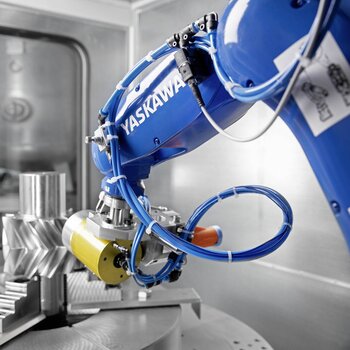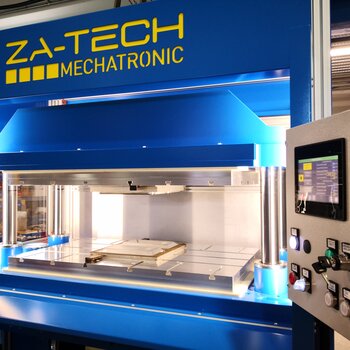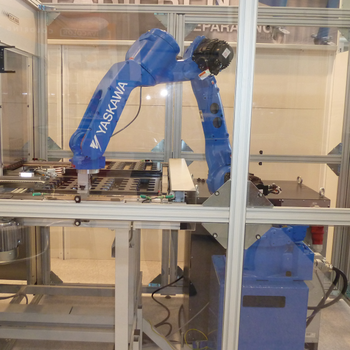Med den bedste robotteknologi vil vi også gerne levere til dig.
Material Removal
Yaskawa Denmark LØSNINGER Applications Material Removal
Overview
Robots for Precise Mechanical Material Removal
Machining, Milling, Drilling/Boring, Reaming, Deburring, and more with Motoman Robots
Since decades, Yaskawa Motoman Robots have been excessively used in a wide range of robotic solutions for all kind of cutting, finishing, polishing, grinding, milling, deburring or other material removal applications. The reason is that MOTOMAN Robots offer the right composition of industrial rigidity, stiffness, sensitivity and dust-/liquid proof kind of design which you could expect from a 6-axis-robot challenged by such tough applications - often being heavily exposed to unpredictable external forces, vibration, dust, chips, liquids and all kind of challenging workpiece geometry variations.
For material removal applications, we recommend our GP Series robots, providing a good balance between long reach and stiffness. For larger workpieces or extending the motion range, it is more reasonable to put the robot and a track instead of selecting a robot model with a long arm. Yaskawa Controllers are known for their excellent path performance, generating best-of-class straight and circular motions over a broad motion envelope.
Engineering Tools for the Workcell Layout - MotoSim
Robotic material processing systems are often required to perform multiple tasks or processing steps -- cutting and deburring, sanding and polishing, grinding steps with different grain sizes etc. Two approaches – multiple spindles or spindles that can change media or tools – can be used to perform the various tasks. The robot may handle the tool or the workpiece. Each application requires some engineering to define the right cell design setup and the optimum robot pose. Experienced Yaskawa Motoman application engineers will help you determine the best approach for your project, often with the help of our Engineering tools like MotoSim. MotoSim does include a CAM function to generate a robot path for milling.
CAD/CAM Engineering Tools (CAD-to-Path) for Path Generation
Material Processing Applications are often programmed through CAD/CAM Simulation tools, using G-Code Standard Interfacing to the robot controller for automatic path generation straight out from the CAD model. Our tool MotoSimEG-VRC provides some functionality to do so, but you will also find Motoman Robots registered in the libraries of almost all common 3rd-Party CAD/CAM Software tools available on the market.
Force Controlled Material Removal
In order to ensure constant surface pressure on contoured products, an active force controlled or sensing device is often used to optimize the finish on the part and increase efficiency of using abrasive consumables. Sometimes Vision systems may be involved to guide the robot or do quality inspection. All kinds of digital, analogue and Fieldbus Sensor Interface options are available on our FS100/YRC1000 robot controllers, making sure to deal with the required high speed signal interfacing to control the process.
Robotic Milling with GP Series Robots
Compared to stationary CNC controlled 5-Axis-Milling machines, which are stiff enough to process all kind of steel parts, the kinematic 6-axis-structure of an Industrial Robot works well with softer materials like Aluminium (e.g. ladders, Handrails, Scaffolding elements), Sand (Sand moulds), Wood (Furniture), Polystyrene (Prototyping) and any kind of plastic, e.g. for 3-D-shaping of industrial or orthopaedic products. The Motoman Robot Portfolio helps you to find the right compromise of the robot arm length - a short arm is good for stability, a long arm is good for large workpieces, ceiling mounted robot arrangements may be a good compromise to gain a maximum reach on a table. Also here, good idea to check if the robot can move the workpiece upfront a stationary spindle. For heavy duty environments, like sanding dust or permanent exposure to aggressive cooling liquids), we recommend our robot models with high IP65/67 protection and/or special anti-corrosive coatings (GP-ACC-Series). And, if you really go for Stationary CNC Milling machines to process the parts, please consider to use Robots for Machine Tending Automation (loading/unloading parts from/to the machine).
Motoman Robots milling Stones
Motoman Robots machining hard Steel
Machining hard steel is possible, but process parameters need to be carefully adjusted to avoid vibration.
Motoman robots machining aluminum
In this application example, the robot moves the workpiece around a stationary tool.
Motoman Robots milling Cork Material
The softer the material, the easier the job is for robots. Motoman Robots can produce exciting 3D-shaped geometries.
Motoman Robots shaping Foams and Polystyrene
Motoman Robots handling workpieces on a stationary Milling Machine
Deburring / Chamfering with Motoman GP Series Robots
Many companies have problems to find employees for deburring jobs, being regarded as trivial, repetitive and boring. Unfortunately deburring jobs require endurance, patience and precision - a perfect starting point to think about robotic automation!
For automatic deburring of machined CNC Parts, you could use any GP Series Robot, selected by payload and reach for the size of your part. Many CNC Machining customers combine the machine tending operation with deburring and inspection jobs in the idle time while the CNC machining cycle is running. The kinematic versatility and the superb path precision of our GP Series 6-axis Robots allow deburring of workpieces with complex geometries.
Another concept is to bring patches of parts to a dedicated deburring station.
Deburring of casted parts may require robotic force controlled deburring tools.
Some Deburring applications require Machine Vision, e.g. if you have undefined moulding residues to be removed. Large workpieces may sit on pallets (not fixed), and a 2D or 3D Machine Vision System (Motosight2D) can communicate the individual workpiece position to the robot. Really high end solutions use more advanced vision technology to detect and deal with random-sized burrs.
Deburring / Chamfering with Motoman GP Series Robots
Many companies have problems to find employees for deburring jobs, being regarded as trivial, repetitive and boring. Unfortunately deburring jobs require endurance, patience and precision - a perfect starting point to think about robotic automation!
For automatic deburring of machined CNC Parts, you could use any GP Series Robot, selected by payload and reach for the size of your part. Many CNC Machining customers combine the machine tending operation with deburring and inspection jobs in the idle time while the CNC machining cycle is running. The kinematic versatility and the superb path precision of our GP Series 6-axis Robots allow deburring of workpieces with complex geometries.
Another concept is to bring patches of parts to a dedicated deburring station.
Deburring of casted parts may require robotic force controlled deburring tools.
Some Deburring applications require Machine Vision, e.g. if you have undefined moulding residues to be removed. Large workpieces may sit on pallets (not fixed), and a 2D or 3D Machine Vision System (Motosight2D) can communicate the individual workpiece position to the robot. Really high end solutions use more advanced vision technology to detect and deal with random-sized burrs.
Drilling and Reaming with Motoman Robots
Compared to stationary drilling machines, Robots are handicapped in terms of precision du to their pose-depending 6-axis-motion kinematic structure, and really well suited only for rather short drilling lengths. Drilling including removal of chips or other CNC processing residues may be easier than you think...






















